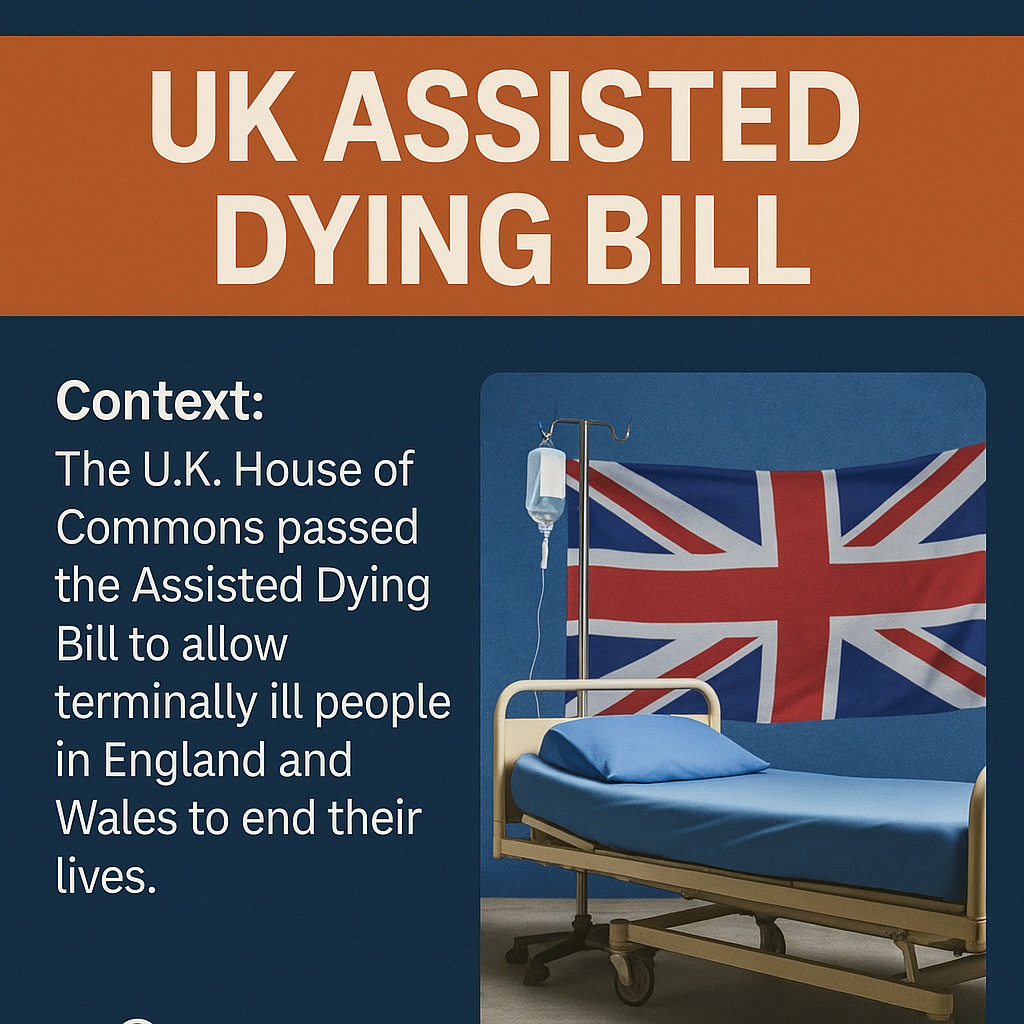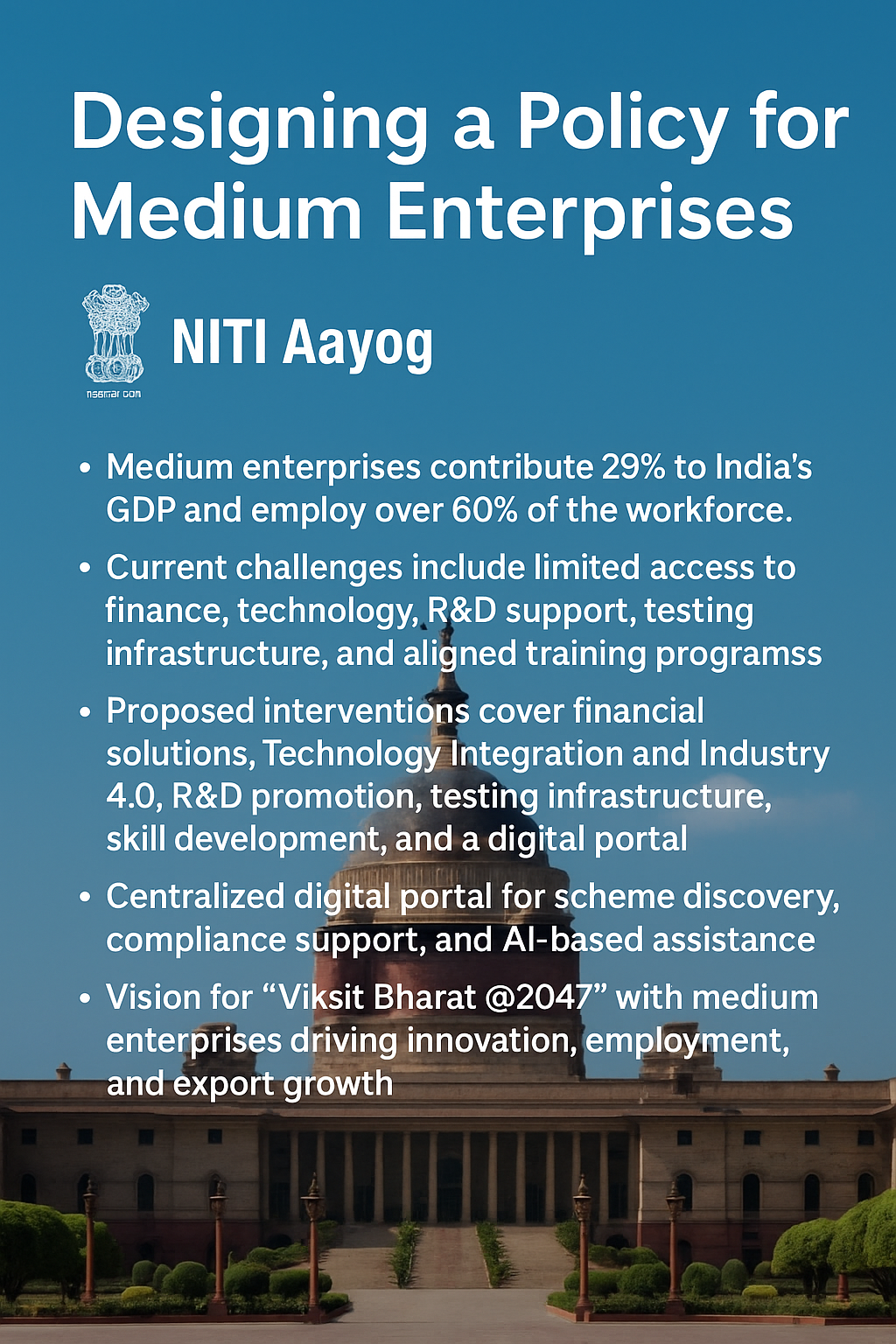
🧭June 21, 2025 Post 3: To End with Dignity or Not at All? | High Quality Mains Essay: To Die With Dignity: Ethics, Law, and the Future of Assisted Dying in India and Beyond | For IAS-2026 :Prelims MCQs
🕊️ To End with Dignity or Not at All?

NATIONAL Heroes— PETAL 003
🗓️ Post Date : June 21, 2025
📚 GS2: Polity, Health | GS4: Ethics & Integrity
🧭 Thematic Focus:
UK’s Assisted Dying Bill | Right to Die with Dignity | Global Ethical Perspectives
🌿 Opening Whisper
“Is death the end of pain, or the start of human dignity reclaiming its final choice?”
🔍 Key Highlights
- The UK House of Commons recently passed the Assisted Dying Bill, allowing terminally ill individuals in England and Wales—diagnosed with less than six months to live—to opt for medically assisted death under strict protocols.
- The law mandates clearance from two doctors, a psychiatrist, and legal/social review to ensure competence and informed consent.
- Globally, countries like Switzerland, Belgium, Spain, Austria, New Zealand, and select U.S. states allow some form of assisted dying or euthanasia.
- In India, the Supreme Court (2018) recognised the right to die with dignity, permitting passive euthanasia through “living wills,” while draft guidelines were issued by the Health Ministry (2024).
- Ethical debates swirl around autonomy, sanctity of life, risk of coercion, and medical ethics.
- Goa is the first Indian state to initiate local implementation of SC guidelines on passive euthanasia.
🧠 Concept Explainer: What is Assisted Dying?
Assisted Dying refers to helping a terminally ill person voluntarily end their life. It manifests in two forms:
- Assisted Suicide: The person self-administers life-ending medication prescribed by a medical practitioner.
- Euthanasia: The physician directly administers a lethal substance to end life painlessly.
Legalisation differs globally — while Europe leads with regulated systems, India cautiously allows passive methods but not active euthanasia.
📘 GS Paper Mapping
GS2 – Governance & Polity:
- Right to Life under Article 21
- Role of Judiciary (SC 2018 Passive Euthanasia Judgment)
- Legislative-Executive interface in healthcare laws
GS4 – Ethics in Governance:
- Ethical dilemmas in healthcare and end-of-life choices
- Human dignity vs. sanctity of life
- Professional ethical conflicts for doctors
💭 A Thought Spark — by IAS Monk
“If birth is not our choice, but we celebrate its dignity, then why is a peaceful exit — chosen in consciousness — feared as defeat? Sometimes, dying is not about ending life. It’s about reclaiming it.”
High Quality Mains Essay For Practice :
Word Limit 1000-1200
“To Die With Dignity: Ethics, Law, and the Future of Assisted Dying in India and Beyond”
The question of life and death has long perplexed moral philosophers, lawmakers, and theologians. Yet in the modern era of advanced healthcare and prolonged terminal suffering, the right to die has become a deeply contested and complex issue. The recent passing of the Assisted Dying Bill in the United Kingdom’s House of Commons has once again reignited the global debate. Is the act of ending one’s own life in the face of irreversible terminal illness a humane act of dignity, or a dangerous precedent that could normalize quiet elimination of the vulnerable? This essay explores the multidimensional aspects—ethical, legal, medical, and cultural—of assisted dying, tracing the evolving discourse both globally and within the Indian context.
The Moral Landscape of Assisted Dying
At the core of assisted dying lies a profound ethical tension between the sanctity of life and personal autonomy. The traditional view—rooted in religious doctrines and long-standing medical ethics—holds that life is inviolable and only a higher force (God, Nature, Destiny) has the authority to end it. From this lens, any form of suicide or assisted death is inherently immoral.
Yet, as societies evolve and secular reasoning gains prominence, new moral frameworks have emerged. Proponents of assisted dying argue that if life is an individual’s fundamental right, then so must be the right to end it—especially in cases where life has become a prolonged episode of suffering and indignity. The principle of autonomy demands that a rational individual must be empowered to make decisions about their own body, including the decision to die, provided it does not harm others.
The UK’s Bill: A Turning Point?
The United Kingdom’s Assisted Dying Bill allows terminally ill individuals with less than six months to live, and who are of sound mental health, to seek medically supervised death. The proposed safeguards—requiring approval by two doctors, a psychiatrist, and even legal and social audits—reflect a conscious effort to prevent misuse. It seeks to humanize death while ensuring it remains a last-resort option.
The UK’s legislation is not entirely novel. Other nations have traversed similar legal terrain. Switzerland has long permitted assisted suicide, and countries like Belgium, the Netherlands, and Canada have moved beyond terminal illness criteria to allow even mental health patients to opt for euthanasia in extreme cases. These shifts point to a growing acceptance of assisted dying as a humane healthcare choice in liberal democracies. Yet they also raise deep philosophical concerns: At what point does the line between autonomy and abandonment of the vulnerable begin to blur?
India’s Legal Evolution: From Right to Live to Right to Die
In India, the debate around euthanasia has evolved gradually. The landmark Supreme Court judgment in Common Cause vs Union of India (2018) recognised the right to die with dignity as part of the fundamental right to life under Article 21. Passive euthanasia was legalised, subject to strict conditions. Importantly, the concept of a “living will” was introduced—an advance directive that allows individuals to state their preference regarding withdrawal of life support if they are ever rendered terminally ill and incapacitated.
In 2024, the Indian Ministry of Health released draft guidelines aimed at operationalising passive euthanasia in public hospitals. Goa became the first state to move toward structured implementation. Yet, the system remains underdeveloped—plagued by social stigma, medical ambiguity, and ethical hesitation.
India does not permit active euthanasia or assisted suicide, and the cultural context remains largely conservative. Many physicians are reluctant to discuss end-of-life choices, and family dynamics often overshadow patient autonomy. But a silent shift is underway. Urban, educated populations are beginning to question the ethics of prolonging pain when no cure is available.
Global Trends and Comparative Legal Systems
The global legal landscape of assisted dying is fragmented. While Western Europe and a few American states have embraced forms of euthanasia, much of Asia and Africa continue to treat it as either illegal or morally unacceptable. Canada, in particular, has sparked global debate with its expansive approach, even permitting assisted death for non-terminal conditions under the Medical Assistance in Dying (MAiD) law. This expansion has been applauded by advocates for choice and condemned by human rights defenders concerned about the message it sends to disabled or poor individuals who may feel their lives are “less valuable.”
This divergence reveals a crucial insight: laws surrounding assisted dying are not only legal instruments but mirrors reflecting the cultural, spiritual, and moral values of a society. What may be ethical in Belgium may be abominable in Bangladesh. Legal reform must, therefore, balance universal rights with local ethos.
The Ethical Dilemmas and Risk of Misuse
While the philosophical arguments in favor of assisted dying are compelling, the counterarguments deserve equal attention. Critics argue that vulnerable populations—such as the elderly, disabled, mentally ill, or economically marginalized—may be pressured into seeking death as a means of reducing burden on families or society. The “right to die” could slowly morph into a “duty to die.”
Medical professionals too face dilemmas. Their core commitment is to heal and preserve life, not to end it. The Hippocratic Oath historically forbids doctors from administering lethal drugs. Although modern interpretations have evolved, the moral weight of “doing no harm” remains profound.
Additionally, there is the challenge of assessing mental competence. How does one determine that a person seeking assisted death is free from depression, coercion, or misinformed judgment? While laws provide procedures, human emotion and bias can infiltrate even the most well-designed systems.
India’s Ethical Position: The Middle Path?
India’s cautious approach offers a model of ethical middle ground. By recognising passive euthanasia and legalising advance directives, the Indian state has acknowledged the importance of personal choice without rushing into legalising active euthanasia. The draft guidelines of 2024 further attempt to bring clarity, allowing doctors to withdraw life-support systems under specific medical and ethical protocols.
However, the implementation gap remains large. There is insufficient training for doctors on end-of-life care, no nationwide digital registry of living wills, and widespread public ignorance about legal rights related to terminal illness. Public dialogue, therefore, becomes critical—not merely to advocate for or against euthanasia, but to sensitise citizens and professionals to the reality of terminal suffering and ethical decision-making.
The Way Forward: Balancing Dignity with Duty
Assisted dying, ultimately, is not just about death. It is about the kind of life one wishes to lead—and end. As medical technology advances and lifespans increase, societies must confront the paradox of keeping people alive even when life itself becomes unbearable.
For India, the future lies in expanding palliative care services, training doctors in ethical counselling, setting up regulatory bodies for end-of-life oversight, and building digital infrastructure for tracking living wills. Equally, fostering a mature public conversation through schools, media, and spiritual forums can prepare the moral ground.
Laws must always follow life. And life, as always, must honour both pain and dignity.
IAS Monk’s Closing Whisper
“The right to die is not the surrender of life, but a brave pause in its melody—where silence speaks louder than breath, and peace becomes the final word of choice.”
Target IAS-26: Daily MCQs :
📌 Prelims Practice MCQs
Topic: Assisted Dying Bill and India
MCQ 1 – Type 1: How many of the above statements are correct?
Q. Consider the following statements regarding Assisted Dying across the world:
1. The United Kingdom’s Assisted Dying Bill allows euthanasia for individuals with mental health conditions, irrespective of terminal illness.
2. Switzerland was among the first countries to legalize assisted dying.
3. Canada allows Medical Assistance in Dying (MAiD) even for non-terminal conditions.
4. The Netherlands and Belgium permit both euthanasia and assisted suicide under strict conditions.
How many of the above statements are correct?
A) Only two
B) Only three
C) All four
D) Only one
🌀 Didn’t get it? Click here (▸) for the Correct Answer & Explanation
✅ Correct Answer: B) Only three
🧠 Explanation:
•1) ❌ False – The UK Bill permits assisted dying only for terminally ill individuals with less than six months to live.
•2) ✅ True – Switzerland legalized assisted dying in 1942, making it one of the first.
•3) ✅ True – Canada’s MAiD law extends even to those whose conditions are not terminal.
•4) ✅ True – Both countries have legalized euthanasia and assisted suicide under regulated frameworks.
MCQ 2 – Type 2: Two Statements Based
Q. Consider the following statements:
1. The Supreme Court of India legalised passive euthanasia and recognised the right to die with dignity as a fundamental right under Article 21.
2. India has legalised active euthanasia for terminally ill patients through a constitutional amendment.
Which of the above statements is/are correct?
A) Only 1 is correct
B) Only 2 is correct
C) Both are correct
D) Neither is correct
🌀 Didn’t get it? Click here (▸) for the Correct Answer & Explanation
✅ Correct Answer: A) Only 1 is correct
🧠 Explanation:
•1) ✅ True – In 2018, SC legalised passive euthanasia and affirmed the right to die with dignity.
•2) ❌ False – India has not legalised active euthanasia. It remains prohibited.
MCQ 3 – Type 3: Which of the statements is/are correct?
Q. Which of the following statements about India’s guidelines on end-of-life care are correct?
1. A living will is a legal document indicating a person’s preference to withdraw life support when terminally ill.
2. The 2024 draft guidelines allow doctors to withhold life support if it provides no therapeutic benefit.
3. Goa is the only state to have a law on active euthanasia.
Select the correct code:
A) 1 and 2 only
B) 2 and 3 only
C) 1 and 3 only
D) All of the above
🌀 Didn’t get it? Click here (▸) for the Correct Answer & Explanation
✅ Correct Answer: A) 1 and 2 only
🧠 Explanation:
•1) ✅ True – A living will expresses end-of-life care preferences.
•2) ✅ True – The Health Ministry’s 2024 draft allows withdrawal if treatment is futile.
•3) ❌ False – Goa does not allow active euthanasia; it has begun formalising passive euthanasia directives.
MCQ 4 – Type 4: Direct Fact
Q. Which Article of the Indian Constitution was cited by the Supreme Court to recognise the right to die with dignity?
A) Article 19
B) Article 14
C) Article 21
D) Article 32
🌀 Didn’t get it? Click here (▸) for the Correct Answer & Explanation.
✅ Correct Answer: C) Article 21
🧠 Explanation:
••Article 21 guarantees the Right to Life, and the Supreme Court interpreted it to include the right to die with dignity in the 2018 euthanasia judgment.


















